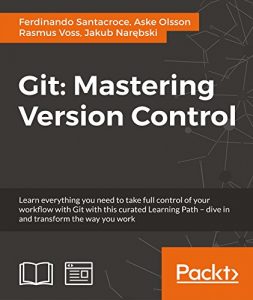Learn everything you need to take full control of your workflow with Git with this curated Learning Path – dive in and transform the way you work
About This Book
- Master all the basic concepts of Git to protect your code and make it easier to evolve
- Filled with practical recipes that will teach you how to use the most advanced features of the Git system
- Harness the full power of the Git version control system to customize Git behavior, manipulate history, integrate external tools, and explore platform shortcuts
Who This Book Is For
This learning path is for software developers who want to become proficient at using the Git version control system. A basic understanding of any version control system would be beneficial.
What You Will Learn
- Transport your work to a remote repository in a centralized manner
- Experiment with your code without affecting functional code files
- Explore some tools used to migrate to Git from other versioning systems without losing your development history
- Understand the Git data model and how you can navigate the database with simple commands
- Debug with Git and use various techniques to find faulty commits
- Customize Git behavior system-wide, on a per-user, per-repository, and per-file basis
- Master administering and setting up Git repositories, configuring access, finding and recovering from repository errors, and performing repository maintenance
- Chose a workflow and configure/set up support for the chosen workflow
In Detail
Git is one of the most popular types of Distributed Version Control System. Since its inception, it has attracted skilled developers due to its robust, powerful, and reliable features. Like most powerful tools, Git can be hard to approach for the newcomers. However, this learning path will help you overcome this fear and become adept at all the basic and advanced tasks in Git.
This course starts with an introduction to version control systems before you delve deeply into the essentials of Git. This serves as a primer for the topics to follow such as branching and merging, creating and managing a GitHub personal repository, and fork and pull requests. You'll also learn how to migrate from SVN using Git tools or TortoiseGit and migrate from other VCSs, concluding with a collection of resources, links, and appendices.
As you progress on to the next module, you will learn how you can automate the usual Git processes by utilizing the hook system built into Git. It also covers advanced repository management, including different options to rewrite the history of a Git repository before you discover how you can work offline with Git, how to track what is going on behind the scenes, and how to use the stash for different purposes.
Moving forward, you will gain deeper insights into Git's architecture, its underlying concepts, behavior, and best practices. It gives a quick implementation example of using Git for a collaborative development of a sample project to establish the foundation knowledge of Git operational tasks and concepts. By exploring advanced Git practices, you will attain a deeper understanding of Git's behavior, allowing you to customize and extend existing recipes and write your own.
This Learning Path is a blend of content, all packaged up keeping your journey in mind. It includes content from the following Packt products:
- Git Essentials, Ferdinando Santacroce
- Git Version Control Cookbook, Aske Olsson and Rasmus Voss
- Mastering Git, Jakub Narebski
Style and approach
Its step-by-step approach with useful information makes this course the ultimate guide to understanding and mastering Git. This course will show the road to mastery example by example, while also explaining the mental model of Git.



